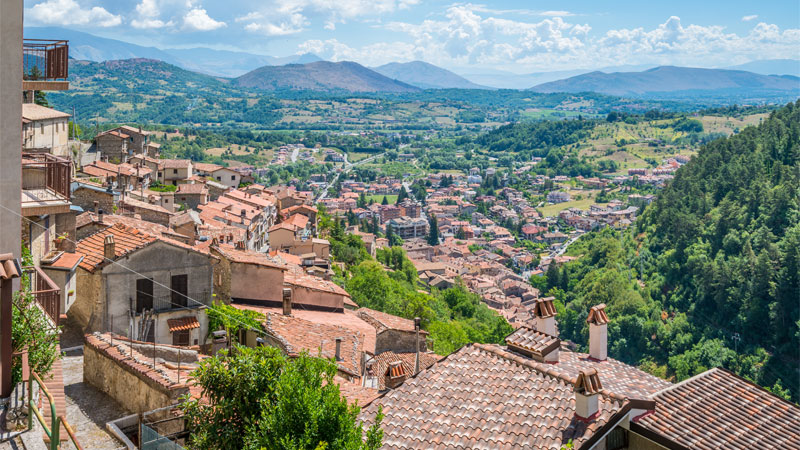A crowd gathers around Fausto Albanesi, the bespectacled winemaker from Torre dei Beatti, at a wine festival in Abruzzo, Italy in May 2019. An English Master of Wine scribbles in his notebook as he praises the “wonderful softness” of Albanesi’s “Rosa-ae” Cerasuolo d’Abruzzo DOC 2018, while a reporter Delhi thoughtfully swirls her glass.
“Italian sommeliers say you can serve Cerasuolo with anything. It combines the freshness of rosé with the robustness of Montepulciano,” Albanesi says. The group at his booth murmurs appreciatively.
Cerasuolo means “cherry” in Italian, and Cerasulo d’Abruzzo wines like Torre dei Beatti’s have a deep, almost garnet color that distinguishes them from pale, Provencal-style rosés that dominate the American market. They are made from Montepulciano d’Abruzzo, the grape that comprises some 80 percent of DOC wine production in Abruzzo, a region two hours east of Rome.
If you haven’t heard of Cerasuolo d’Abruzzo DOC before, it’s understandable. The designation was created in 2010. To add to any possible confusion, there’s a similarly named Sicilian wine, Cerasuolo di Vittoria.
Quality Cerasuolo d’Abruzzo wines are tannic, with more structure and nuance than many of the Provencal-style bottles American rosé drinkers might call “crushable.” The style has a lot to offer, appealing to those who casually drink pink wine at summer parties, and to industry folks who prefer their Cru Beaujolais and Etna reds served with a slight chill.
Charlie Arturaola, a sommelier based in Miami, praises the versatility of Cerasuolo d’Abruzzo with different foods. “It nearly has the structure of a red wine,” he says. “Think outside the box next time you eat dim sum, Thai, or Korean cuisine.”
Cerasuolo gets its namesake color from very limited contact with the dark-hued skins of Montepulciano grapes.
“It should be this cherry color,” Valentina di Camillo, winemaker at Abruzzo’s Tenuta I Fauri, says, gesturing to a bottle of Fauri’s lean, angular Cerasuolo. “A lot of winemakers are changing their color because the Provencal style is so popular … But the natural color is this. The skins of Montepulciano are full of color.”
Cerasuolo d’Abruzzo is typically fermented and aged for three or so months in stainless steel. Unlike red Montepulciano wines, many of which benefit from bottle aging, Cerasuolos are meant to drink young.
“This is the wine families used to drink in the region because it’s strong enough to face any kind of food, lamb or pork or pasta or even fish,” di Camillo says. “It’s a really refreshing wine, a very drinkable wine.”

Cerasuolo d’Abruzzo is generally pretty affordable in the United States, too. A Cerasuolo from Masciarelli Villa Gemma made VinePair’s list of the top 25 rosés of 2019 and clocks in around $12 a bottle.
The biggest hurdle Cerasuolo d’Abruzzo faces among American consumers is its distinctive color. The legacy of White Zinfandel casts a long, embarrassing shadow for many drinkers, leading them to assume darker rosés are going to be saccharine, and pale rosés will be more balanced and better quality.
“As with most things, wine is not only about what meets the naked eye. The color of a wine doesn’t actually say anything about the sweetness level; you can easily find a deep-pink wine that is bone dry!” Rebecca Meir, wine writer and sommelier, Chef & Somm, writes VinePair in an email. “This mentality is something we need to unlearn, as it is only a state of mind.”
Cerasuolo d’Abruzzo is, in the words of winemaker Marina Cvetic, a “serious rosé wine.” The best bottles balance flavors of pomegranates, strawberries, and, of course, cherries with lime juice and licorice, plus excellent structure worthy of dinner parties with your most discerning friends.
Besides, it would be a shame to write off the entire category due to a superficial misperception. “When we generalize and make our opinions about a wine flavor based on its color instead of actually tasting it, we naturally gravitate towards our past, learned attitudes,” Meir says. “We need to first learn to appreciate what is inside.” She’s talking about wine, of course, but it’s pretty great life advice, too.
5 Cerasuolo d’Abruzzo Wines to Try
Many of the region’s bottles are exported internationally. Others, like the exemplary Emidio Pepe Montepulciano d’Abruzzo Cerasuolo, were not available in the U.S. at press time.
Tenuta I Fauri Baldovino Cerasuolo d’Abruzzo 2018
Bright and beautifully balanced, this exceptional example of Cerasuolo’s complexity offers impressive value for money. Average price: $9.
Cerasuolo d’Abruzzo DOC Masciarelli Villa Gemma 2018
Dark cherries, strawberries, mint, and a hint of lime oil lend complexity to this rich, round Cerasuolo. Average price: $12.
Cataldi Madonna Cerasuolo d’Abruzzo 2018
Fruity and bright, with both berry and nutty notes, this 100 percent Montepulciano d’Abruzzo wine is fermented and aged in stainless steel. Average price: $12.
2018 Cantina Zaccagnini ‘dal Tralcetto’ Montepulciano d’Abruzzo Cerasuolo
From Zaccagnini’s modern-art-strewn grounds in Pescara comes this lean, lovely Cerasuolo with notes of wild strawberries, zippy lemon zest, and balsamic vinegar, followed by a balanced, minerally finish. Average price: $14.
2018 Torre dei Beatti ‘Rosa-ae’ Cerasuolo d’Abruzzo
A favorite at a recent industry tasting, this Cerasuolo balances its expressive berries with zest, minerally notes, and impressive structure. This is great wine to bring to a dinner party, too; it’s impressive but not flashy, and versatile while still maintaining character. Average price: $18.
